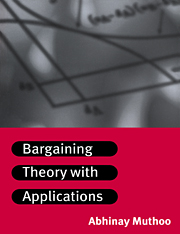6 - Inside Options
Published online by Cambridge University Press: 24 November 2009
Summary
Introduction
Consider the basic exchange situation in which a seller and a buyer are bargaining over the price at which the seller sells an indivisible object (such as a house) to the buyer. If agreement is reached on price p, then the seller's payoff is p and the buyer's payoff is π – p. Furthermore, the seller obtains utility at rate gs while the object is in her possession, where gs ≥ 0; thus, for Δ > 0 but small, she obtains a payoff of gsΔ if she owns the house for Δ units of time. Given her discount rate rs > 0, this means that if she keeps possession of the house forever, then her payoff is gs/rs, which is assumed to be less than π — for otherwise gains from trade do not exist. The payoff that the seller obtains while the parties temporarily disagree is her inside option — which equals gs[1 – exp(–rsΔ)]/rs if they disagree for Δ units of time. In contrast, her outside option is the payoff she obtains if she chooses to permanently stop bargaining, and chooses not to reach agreement with the buyer; for example, this could be the price p* (where p* > gs/rs) that she obtains by selling the house to some other buyer.
A main objective of this chapter is to explore the role of inside options on the bargaining outcome.
- Type
- Chapter
- Information
- Bargaining Theory with Applications , pp. 137 - 186Publisher: Cambridge University PressPrint publication year: 1999



